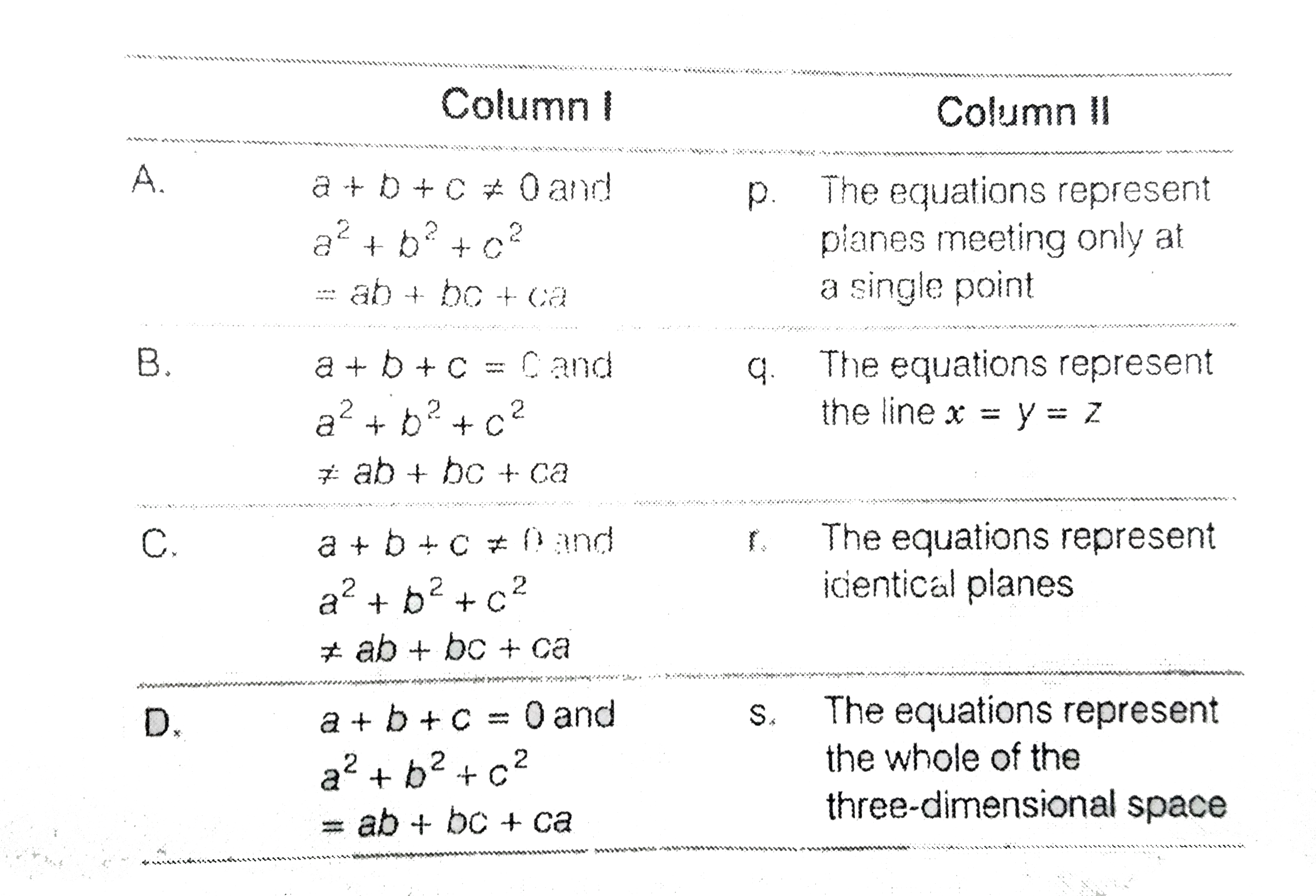Consider the following linear equations
ax+by+cz=0,bx+cy+az=0,cx+ay+bz=0

The correct Answer is:A→r,B→q;C→p;D→s
LetΔ=∣∣
∣∣abcbcacab∣∣
∣∣
=−12(a+b+c)[(a−b)2+(b−c)2+(c−a)2]
A, If a+b+c≠0 and a2+b2+c2=ab+bc+ca
⇒ Δ=0
and a=b=c≠0
⇒ The equations represent identical planes.
B. a+b+c=0 and a2+b2+c2≠ab+bc+ca
⇒Δ=0
⇒ The equations have infinitely many solutions.
ax+by=(a+b)z,bx+cy=(b+c)z
⇒ (b2−ac)y=(b2−ac)z⇒y=z
⇒ ax+by+cy=0⇒ax=ay⇒x=y=z
C.a+b+c≠0 and a2+b2+c2=ab+bc+ca
⇒ Δ≠0
The equations represent planes meeting at only one point.
D. a+b+c=0 and a2+b2+c2=ab+bc+ca
⇒ a=b=c=0
⇒ The equations represent whole of the three-dimensional space.
Topper's Solved these Questions
- BOOK - IIT JEE PREVIOUS YEARCHAPTER - 3D GeometryEXERCISE - Equation of Plane Objective Question II (Integer Answer Type Question)1videos
3D Geometry
- BOOK - IIT JEE PREVIOUS YEARCHAPTER - 3D GeometryEXERCISE - Equation of Plane Objective Question II (Assertion and Reason)2videos
3D Geometry
- BOOK - IIT JEE PREVIOUS YEARCHAPTER - PROPERTIES OF TRIANGLESEXERCISE - CIRCUMCIRCLE, INCIRCLE, ESCRIBED CIRCLE, ORTHOCENTRE,INCENTRE AND CIRCUMCENTRE20videos
PROPERTIES OF TRIANGLES
- BOOK - IIT JEE PREVIOUS YEARCHAPTER - APPLICATION OF DERIVATIVES EXERCISE - MAXIMA AND MINIMA ( INTEGER ANSWER TYPE QUESTIONS)8videos
APPLICATION OF DERIVATIVES
Similar Questions
Knowledge Check
- Question 1 - Select One
If a>b>c and the system of equtions ax +by +by +cz =0,n bx +cy+az=0,cx+ay+bz=0 has a non-trivial solution then both the roots of the equadratic equation
at2+bt+c areAnon-realBof opposite signCpositiveDcomplex - Question 2 - Select One or More
If a>b>c and the system of equtions ax +by +cz =0,n bx +cy+az=0,cx+ay+bz=0 has a non-trivial solution then both the roots of the equadratic equation at2+bt+c are
ArealBof opposite signCpositiveDcomplex - Question 3 - Select One
If a+b+c=0anda2+b2+c2−ab−bc−ca≠0,∀a,b,c∈R then the system of equations
ax+by+cz=0,bx+cy+az=0 and cx+ay+bz=0 hasAA unique solutionBInfinte solutionsCNo solutionDExactly two solutions
If a,b,c∈Randa+b+c=0 and th esystem of equations ax+by+cz=0,bx+cy+az=0,cx+ay+bz=0 has a non-zero solution, then a:b:c is given by
View SolutionConsider the system of equations ax+y+bz=0,bx+y+az=0andax+by+abz=0 where a,b∈{0,1,2,3,4}. The number of ordered pairs (a, b) for which the system has non - trivial solutions is
View SolutionSTATEMENT-1 : If a,b,c are distinct and x,y,z are not all zero and ax+by+cz=0,bx+cy+az=0,cx+ay+bz=0, then a+b+c=0 and STATEMENT-2 : a2+b2+c2>ab+bc+ca, if a,b,c are distinct.
View SolutionIf the system of linear equations
ax+by+cz=0
cx+ay+bz=0
bx+cy+az=0
where a,b,c ∈ R are non-zero and distinct , has a non-zero solution, then :View SolutionIf the system of linear equations
ax+by+cz=0
cx+cy+bz=0
bx+cy+az=0 where a,b,c,∈ R are non-zero and distinct, has a non-zero solution, then:View Solution

